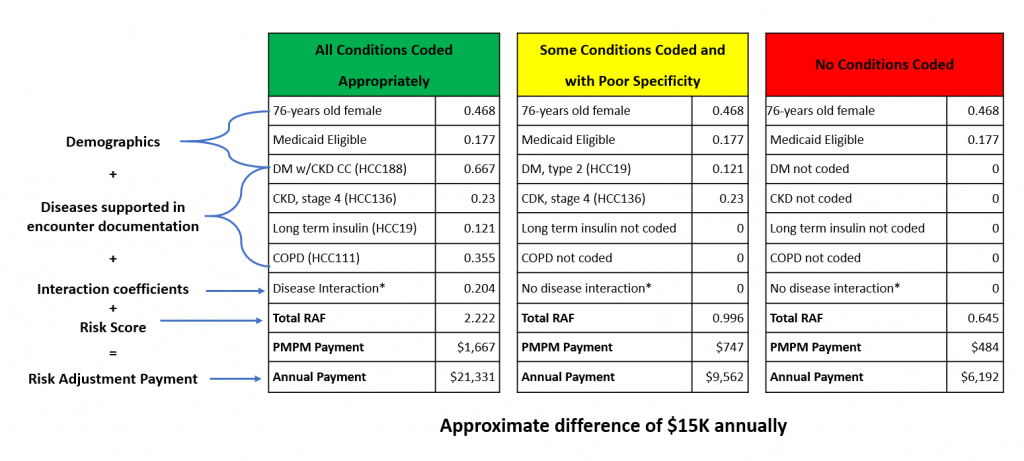
Health plans across the country have begun to realize the superior value of prospective risk adjustment programs, and rightfully so. These programs permit impact at the point of care as opposed to retrospective programs which are essentially chart reviews. Prospective risk adjustment programs permit timely, effective interventions including the presentation of suspected gaps in care and the opportunity to achieve thorough and accurate documentation, which supports conditions coded to the highest degree of specificity. Conversely, backward looking retrospective risk adjustment programs limit effectiveness to code capture. A risk adjustment program which only consists of retrospective chart reviews is myopic in that it does not support the outcomes-driven, population health management focus which is now inherent in most payment models.
You may be asking yourself which one is the optimal approach to risk adjustment? The answer: an effective mix of all of the above, but most importantly, primary care physician (PCP) engagement. A winning risk adjustment strategy is heavily weighted towards prospective interventions and programs but may need to include some retrospective elements to meet physicians’ needs. Prospective programs, while more operationally complex to deliver, are preferred because the ability to impact behavior, at the point of care, is powerful and has significant cascading effects, including higher overall value, return on investment and reduced compliance risk. When coupled with PCP engagement, prospective risk adjustment can be the most effective method for obtaining comprehensive insight into the disease burden of your member population. Prospective risk adjustment also enables forecasting the cost of care for your Medicare Advantage, Medicaid, and Commercial lines of business.
PCP engagement is the key to success across all risk adjustment strategies, especially Prospective programs. PCP engagement improves care delivery and closes gaps in care by leveraging a proactive approach which provides clinical and administrative support, education, and performance management in a timely manner.
The challenge: Finding a prospective risk adjustment program that actually engages PCPs.
Ideally, health plans and physicians would collaborate to reduce costs and improve health, quality, and outcomes. Additionally, members would self-advocate and proactively schedule preventive and wellness visits. Unfortunately, true engagement among all stakeholders in the healthcare continuum is rare and difficult to attain. Physician engagement requires timely, ongoing support. It is essential to augment practices with dedicated clinical resources who curate information to save the physician time by streamlining coding and surfacing gaps in care that require consideration at the time of the encounter. Furthermore, support staff who provide insights on performance and drive physician engagement, are critical to success. Successful programs supply expertly trained people, easy to use technology, turnkey processes, and aligned financial incentives to achieve, and maintain, physician engagement. Lastly, member engagement is also an important piece of the puzzle. Physicians are more likely to engage in programs that drive material clinical improvements for their patients, such as improved outcomes and quality of life.
How Vatica Health can help: Aligning all stakeholders around a common goal
Vatica Health is a compliance-first organization that enables a physician-centric approach to risk adjustment and clinical quality. We pair expert clinical teams with cutting-edge technology to work with physicians at the point of care. Vatica Health synthesizes EMR and health plan data to create the most comprehensive and complete view of each patient. It also provides comprehensive PCP training as well as 100% clinical coding validation. All unsubstantiated codes are deleted prior to submission of the Vatica record to the health plan sponsor.
Advantages of partnering with Vatica Health:
- Our licensed registered nurses and administrative staff are dedicated to providing the absolutely best experience for PCPs and their office staff.
- Our attention to documentation and coding validation (Vatica’s Quality Improvement process) improves accuracy and reduces compliance risk.
- Vatica’s clinical and administrative staff work closely with each practice to develop a custom workflow and process until we achieve the ideal state that yields the most results with the least amount of effort for the physicians.
When health plans partner with Vatica Health, they ensure a comprehensive, collaborative, and prospective risk adjustment program that’s a win-win for everyone, including patients. To learn more, visit https://vaticahealth.com/.



Recent Comments